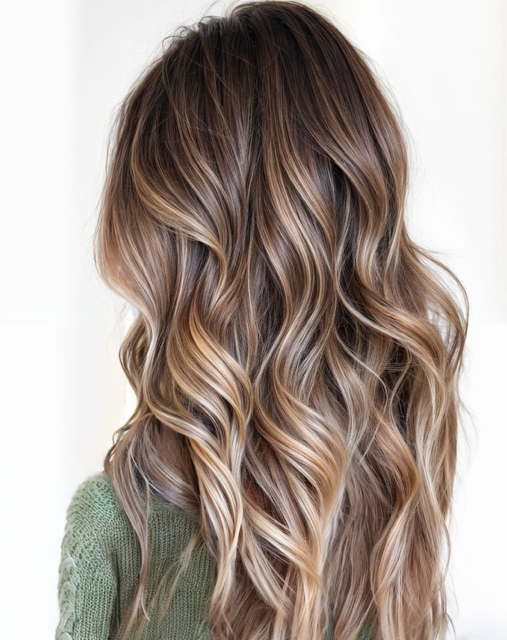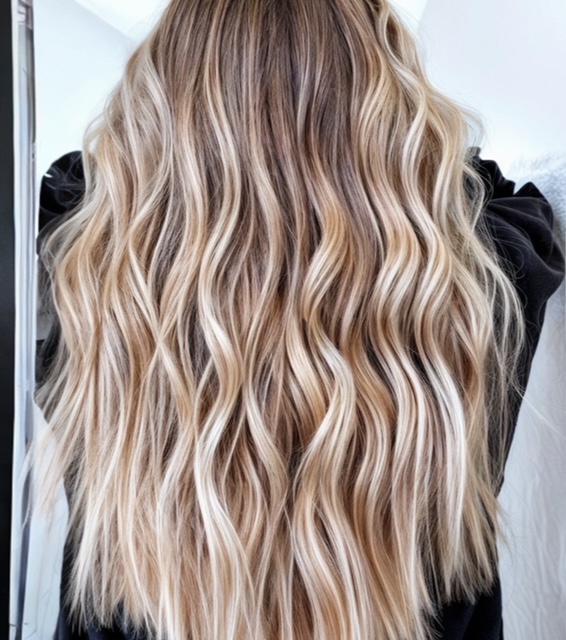The Reverse Balayage
In the realm of hair color artistry, a bold new trend has emerged, defying the conventional and elevating the humble balayage to new heights. The reverse balayage, a subversive twist on the classic technique, is a testament to the boundless creativity of the hair industry's most daring visionaries.

The Unconventional Allure: While the traditional balayage technique involves painting lighter highlights onto the hair's surface, the reverse balayage takes a decidedly unconventional approach. This daring method embraces the art of darkness, strategically weaving rich, dimensional lowlights throughout the hair's lengths and ends, creating a depth and intensity that is both striking and utterly captivating.
The Reverse Balayage Defined: A reverse balayage is a hair coloring technique where darker shades are painted onto the lengths and ends of the hair, rather than the traditional balayage method of applying lighter tones.
How It Works: With a reverse balayage, the stylist starts with your base hair color as the lightest shade. They then use a brush or tinting board to apply darker semi-permanent or demi-permanent dye to the bottom lengths and ends in a gradual, blended way. This creates a subtle dark-to-light gradient from ends to roots.
The Benefits:
- Dimension and Depth: The darker tones add richness and depth to the hair by creating shadows and movement.
- Low Maintenance: The dark color concentrates on just the ends, so less frequent root touch-ups are required compared to single process color.
- Face-Framing: Darker pieces around the face can help contour and slim facial features.
- Versatile: Works on both blondes and brunettes. Blondes get a dimensional caramel effect while brunettes get a soft ombre look.
The Versatile Canvas: One of the greatest strengths of the reverse balayage lies in its adaptability. Whether you crave a sleek and polished look or a tousled, bohemian vibe, this color technique can be tailored to suit any desired aesthetic. From chic updos to beachy waves, the reverse balayage effortlessly complements a multitude of hairstyles, ensuring that your look remains fresh and on-trend.

Maintenance Made Effortless: Contrary to popular belief, maintaining the radiance of the reverse balayage is a seamless endeavor. With the right haircare products and techniques, the rich lowlights will gracefully blend with your natural hue, allowing for a low-maintenance routine that keeps your tresses looking vibrant and healthy.
Understanding the Reverse Balayage Hair Color Technique
The Reverse Balayage Defined: A reverse balayage is a hair coloring technique where darker shades are painted onto the lengths and ends of the hair, rather than the traditional balayage method of applying lighter tones.
How It Works: With a reverse balayage, the stylist starts with your base hair color as the lightest shade. They then use a brush or tinting board to apply darker semi-permanent or demi-permanent dye to the bottom lengths and ends in a gradual, blended way. This creates a subtle dark-to-light gradient from ends to roots.
The Benefits:
- Dimension and Depth: The darker tones add richness and depth to the hair by creating shadows and movement.
- Low Maintenance: The dark color concentrates on just the ends, so less frequent root touch-ups are required compared to single process color.
- Face-Framing: Darker pieces around the face can help contour and slim facial features.
- Versatile: Works on both blondes and brunettes. Blondes get a dimensional caramel effect while brunettes get a soft ombre look.
Choosing Your Shade: Your stylist will help select flattering darker shades that complement your base hair color and skin tone. Popular options include chestnut, mocha, espresso and auburn tones. The darker color should be 2-3 shades deeper than your base.

The Coloring Process: After sectioning the hair, your stylist paints or sweeps the darker dye onto the lengths using a brush or tinting board. They blend and diffuse the color upwards to create the gradient. The dye processes for around 20-30 minutes before rinsing.
Types of Reverse Balayage:
- Subtle Reverse Balayage: Just a few deeper pieces blended into the bottom lengths for enhanced dimension.
- Dramatic Reverse Balayage: Darker color concentrated heavily on the bottom 4-6 inches for a striking contrast.
- Reverse Babylights: Extremely fine, dense streaks of darker pieces for a natural shadowed effect.
Hair Type Considerations: The reverse balayage technique is relatively low-commitment and works well across textures. However, those with very coarse or resistant hair may have a harder time achieving seamless blending.
After-Care Tips:
- Use color-safe shampoo and conditioner
- Apply a gloss or toner every 4-6 weeks to refresh tones
- Limit heat styling to preserve vibrancy
The Trendsetter Effect: Celebs like Hailey Bieber, Dua Lipa and Alexa Chung have rocked reverse balayage looks that combine depth, dimension and low-maintenance. Their signature styles demonstrate the cool versatility of this modern technique.

The Epitome of Confidence: In the world of hair color, the reverse balayage reigns supreme as the epitome of confidence and self-assurance. It's a bold statement that defies conventions and embraces the beauty of contrast and depth. By embracing this trend, you join the ranks of style icons who have elevated hair color to new heights, inspiring others to fearlessly explore the boundaries of beauty.
BOOK YOUR APPOINTMENT AT GUSTO HAIR SALONS IN OXFORD STREET & COVENT GARDEN
To book, please call Gusto Hairdressing Salon Covent Garden Salon on 020 7836 9163, or Oxford Street Salon on 0207 486 5044. Book online for our Covent Garden Salon, or Oxford Street Salon.
For more inspiration, don't forget to check out our socials! Find us on Instagram or Facebook.
